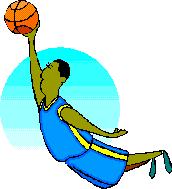If you've gotten this far, you've done well. You've learned to shift your attention and slide into your groove at will. In addition, you know how to handle the distractions that throw most players off their game.
Congratulations! You're done.
You don't really don't need this next section unless you've hit a slump. Feel free to skip it and focus on the techniques for finding your groove.
Internal Messages
We talk to ourselves.
It's natural. We say things like, "Nice car," or "I can't wait to get off my feet," or "Where are my keys?" These internal messages have a variety of effects. Sometimes they can cheer you up; sometimes they can help you through a tough day. "One more hour," has kept many a sales clerk from losing their mind.
The problem starts with messages that have a negative impact. Just as some act as a pick-me-up, others can pull you down. A steady dose of, "I can't get out of this," can drain all your energy.
In sports, disruptive messages will throw you off your game. They're work like big distractions and knock you out of your groove.
Internal disruptive messages are hard to counter. They're coming from within. Your external guards and maneuvers won't work.
The exact content of an internal disruptive message can vary. It might make sense, or it might be stupid. The key is that it throws you off your game.
Examples of disturbing messages:
These messages loosely make sense. Your internal messages can be silly and still throw you off.
Mini Demonstration
If you don't believe that an internal message can increase your stress, here's an experiment you can try:
Typically, you can feel your stress rising just thinking through those messages. And the messages aren't real. Imagine the impact when your mind is creating the messages.
Identifying the Message
The following technique can counter an internal disruptive message.
The first step is to identify the exact message that is disturbing you. You don't need to analyze it, just surface the message.
A list.
Take a sheet of paper and list all the possible messages that could be disturbing you. Fill up the entire sheet. If you can't fill the page, make some up.
For example:
Special items.
Armed with a full page of messages, mark the ones that really get you. Several may stand out.
For example:
Countering It
Finding the particular message that gets to you is a big step. Writing out a full page of issues gives your mind a chance to loosen up and surface the target message.
With the most disturbing messages in hand, you're ready for a counter maneuver.
The Disturbing Message
Write the disturbing message on another sheet of paper.
For example:
The Counter Message
Next, write out a message that negates the disturbing message. Fill the page with these counter messages.
With a full page in hand, scan the list for the best counter message. It's the message that wipes out the disturbing one completely. You should feel your stress drop when you consider the counter message.
For example:
An effective counter message doesn't need to be logical. It doesn't have to make sense. It somehow appeals to your mind, and that's the key.
For example:
This listing technique may seem simple, but it is very powerful. It will take on the toughest of slumps.
The process of writing out the list is important. Just thinking about the issue won't do. Write it out.
Bag of Tricks

Okay, there's only one trick in the bag. Here it is.
You can negate the disrupting message without consciously identifying the specific problem and counter messages from the above exercise.
That sounds good. How?
Let's say that you did the counter-message exercise, but you don't find a good problem and corrective message. You wrote out both pages, but nothing jumped out at you.Here's the trick. The problem went away anyway, even though you didn't consciously find a solution.
Huh? How can that be?
Sometimes the process of writing out and thinking through these steps gets the subconscious mind involved, and it arrives at its own solution. All without letting you know what is was. All you know is that you no longer have the problem.
Comments:
It does sound strange, but it works.
Don't Like to Write
It's critical that the internal disruptive messages and their counters are written out. Whereas other techniques are flexible and offer a mix of stylistic approaches, this one is not.
The reason why has not been proven. The theory is that the writing forces a transfer of information from one hemisphere of the brain to the other. The process and time delay that it takes to moves the information through the brain's synapse somehow allows the unconscious to tackle the issue.
So...something about the act of writing prods the unconscious to get involved and solve the problem. That's almost too tricky, but it is effective.
Comments:

What's Next?
You're done.
You know the techniques for finding your groove and playing your best when it counts. This includes handling distractions, organizing your training to avoid overload, and countering disruptive internal messages.
At this point, you have a tremendous advantage over other players.
Go get'em.
Additional Reading
Experiencing Erickson: An Introduction to the Man and His Work by Jeffrey Zeig. Brunner/Mazel, 1985.
* For those wanting to understand how the subconscious can be guided.
Hypnotic Realities: The Induction of Clinical Hypnosis and Forms of Indirect Suggestion/Book by Milton H. Erickson. Irvington Pub, 1976.
* Dr. Erickson's indirect suggestions offer a way to avoid tug-of-wars with your mind.
| AWSS Home | Previous Section | Next Section |
